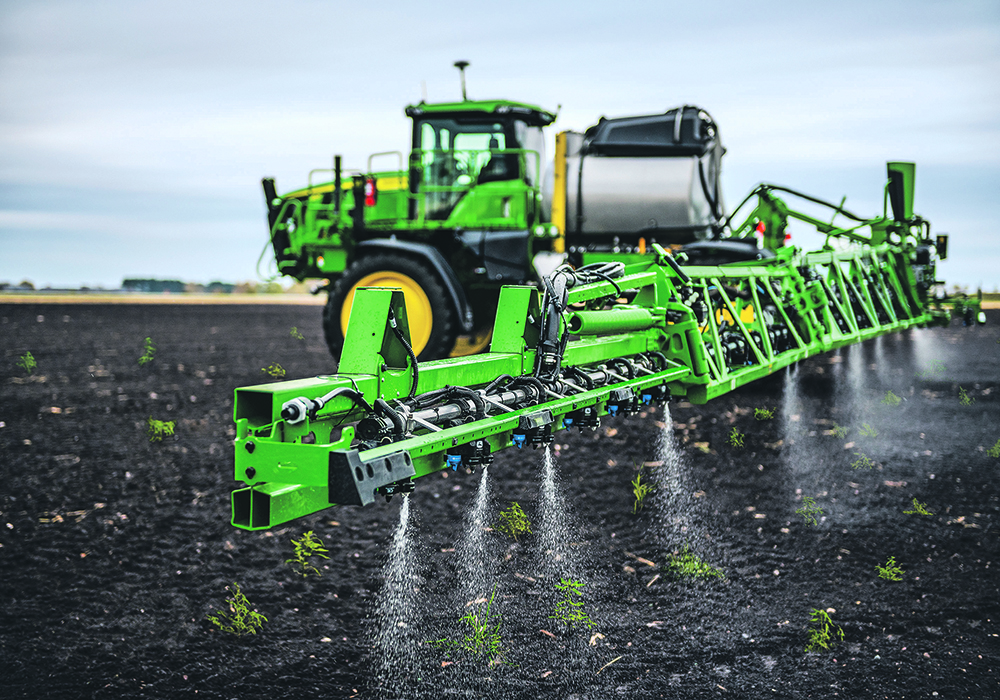New release is a downstream effect of Deere’s investment in Blue River application-technology company four years ago
Find a weed and kill it. Ignore the crop and don’t waste any resources on non-pests. It’s easy to do strolling through a field with a hoe or spray nozzle in hand. Doing it over five- or 10-thousand acres in a tight time window is a bigger job.
Blue River Technology sprang from an idea to use the evolving farm guidance tools, automation and application concepts to tailor a system that could target plants in a field for removal, support or control. It’s now known as See and Spray and in 2017 the company was acquired by John Deere.
Read Also

Trump’s tariffs take their toll on U.S. producers
U.S. farmers say Trump’s tariffs have been devastating for growers in that country.
The system would spot either target plants or an absence of them, potentially differentiate between species or identify plant threats and act accordingly.
The concept helps producers reduce costly over-application of products, use less environmentally interrupting chemicals or enable mechanical responses to yield impairing situations.
This month, Deere began taking orders for the next generation of See and Spray technology integrated into its high capacity sprayers.
Joel Basinger of Deere heads up the roll-out of the new products on the company’s ExactApply, pulse width modulated nozzle system equipped sprayers in the 400 or 600 series for the 2022 model year.
See and Spray Select is a factory-installed spot spray tool that uses 36 cameras mounted on booms up to 120 feet, at speeds up to 12 miles per hour.
“That is reacting to seeing a plant and getting spray to it in 200 milliseconds,” he said.
In an interview last year, Deere’s Julian Sanchez, who heads the machinery maker’s emerging technology efforts, said combining tools such as nozzle-by-nozzle control, pulse width modulation, and See and Spray, with streaming location and rate data that can be sent back and forth between a sprayer and central farm operations is the future of farm equipment and technology.
“We are looking to get the most for the farmer from every single plant. Starting with each seed. The most yield, but in the most efficient way. Farmers’ incomes come from maximizing these things. Yield, but not at the expense of efficiency,” he said.
“Less time, fewer inputs, more crop,” he said.
Sanchez said consumer expectations of producers are that they will feed them, but at the least possible cost to the environment.
In the case of spring burnoff ahead of seeding or planting, Basinger said that farmers could see a potential reduction of glyphosate and other non-residual products by 75 percent or more using the new tools. Or the products can be applied to whole fields, but with the advantages of turn compensation and nozzle control that avoids over and under applying, potentially leading to resistant biotypes of weeds or unwanted crop volunteers.
Basinger said other savings come from lower fluid consumption, which results in fewer tendering stops. While the 12 m.p.h. upper speed might be lower than speeds many small grains producers are used to running, he suggests that is made up for with fewer stops to fill.
“There is a limit to how fast the technology can run. We hope to increase that down the road, but we know it becomes less accurate when you go faster. You want that 10 gallons per acre hitting that weed and doing it right, so speed is always a factor,” he said.
The only additional maintenance for the system is keeping the camera lens side clean and Basinger said that took little effort.
The machines will be available in 90, 100 and 120 foot steel booms starting June 2.
With the added technology, there is a price for that. But it should pencil out quickly, he said.
He said the next steps for the company are to bring the technology to in-crop weed control.
“Fallow ground isn’t the only need for our customers with this technology. We understand that identifying plants we don’t want in a crop and controlling those is critical for (See and Spray) and we are working towards that every day.”















